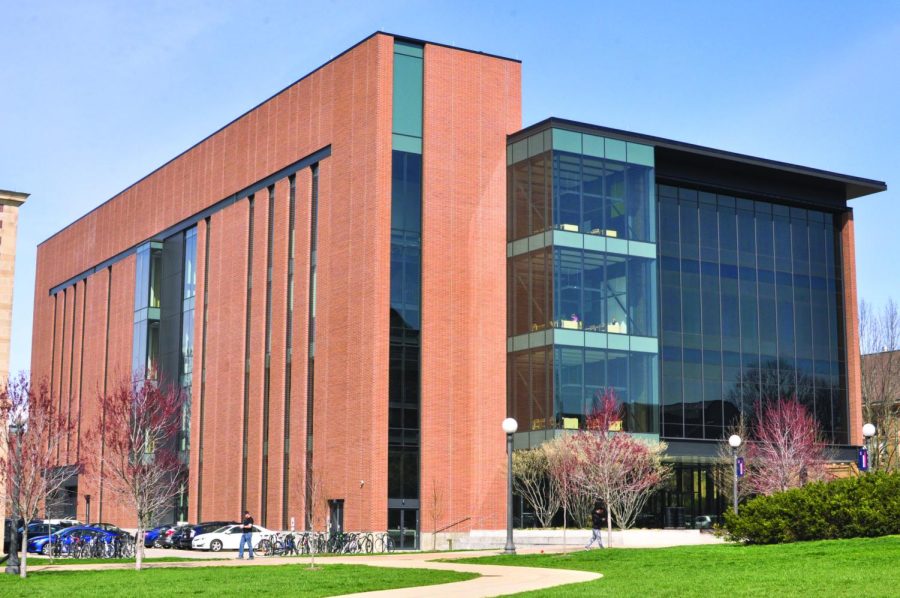UI focuses on geothermal energy in Campus Instructional Facility
The Campus Instructional Facility, located on Wright Street and Springfield Avenue, utilizes geothermal energy for power. The CIF’s infrastructure incorporates radiant panels on the ceiling that connect to boreholes on the Bardeen Quad.
April 19, 2022
As conversations about climate change proceed and become more important to have, it is essential for higher institutions to do their part in protecting the environment.
In an effort to become more sustainable, the University has pledged to be carbon neutral by 2050. One of the initiatives the University pursued to meet that goal was building a geothermal exchange system to heat and cool the recently-opened Campus Instructional Facility.
Geothermal energy is a strategy that brings steam from reservoirs of hot water deep in the Earth to the surface to generate electricity.
But according to Dr. Scott Willenbrock, a professor in Engineering, there are no steam systems in the Midwest, and the underground temperature in the area is low compared to areas with active hot springs.
A large portion of the energy used in the Midwest is from unsustainable resources. Willenbrock saw an issue with that.
Get The Daily Illini in your inbox!
“In Illinois, the dominant form of heating for homes and for buildings is burning natural gas and sometimes coal,” Willenbrock said. “The idea of geothermal is to use electricity for heating.”
During the winter in the Midwest, the underground heat is warmer than in other seasons. So, the geothermal system in the CIF pulls energy from the Earth during the winter.
“The idea of geothermal energy is that in the winter, you can actually pull heat out of the ground,” Willenbrock said. “In the summer, you can dump heat into the ground — that’s what geothermal was all about here in the Midwest.”
Since electricity is used to heat the building instead of fossil fuels, geothermal energy is more environmentally friendly.
On the ceiling of the CIF, there are radiant heat panels that connect to a water supply. The water supply comes from narrow holes dug on the “geothermal field” — Bardeen Quad.
The holes, called boreholes, act as wells that bring the heat from the Earth. There are 40 total, each 450 feet deep. Then, infrared heat panels on the ceiling of the CIF warm the water from the boreholes.
Eric Vetter, the CIF’s facility manager, reports on the condition of the building to the design team and contractors. He said the CIF’s geothermal system is still in a confirmation period.
“We are still working through the contractors to confirm that everything is set up, that all the control valves, all of the liquid is flowing correctly through the radiant panels, and the temperature settings,” Vetter said.
Willenbrock acknowledges that electrifying the heat still uses fossil fuels. However, the amount used in heating the CIF is less than what regular methods would require.
“Even if you were to just leave things as they are currently, switching over to geothermal energy is still better from a carbon dioxide output point of view,” Willenbrock said. “The amount of fossil fuels you use to run a geothermal system is less than you would use if you just use gas or coal for heating.”
Dr. Yu-Feng Lin, project team member and director of the Illinois Water Resources Center, said while there are no current plans for another geothermal building on campus, the center is open to the idea.
“We have been doing a lot of research on campus related to it,” Lin said. “Campus has a lot of brilliant scientists, faculty and good student workers, so we are talking to campus leadership.”
Lin praised the Student Sustainability Committee for its involvement in the project. For example, the committee had civil engineering students attend the borehole drillings with instructors and assess the foundation.
Additionally, computer science students have worked on a website that will track energy and savings for other buildings on the Bardeen Quad. Along with that, the committee allocated $375,000 for the CIF’s geothermal system.
“Students desire and will try to make the people know their power,” Lin said. “That’s the most important part.”







